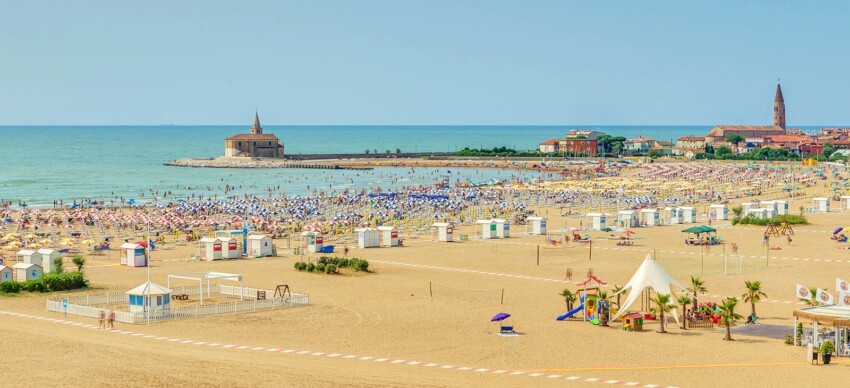

How is it possible that Veneto, a region that certainly cannot boast the bluest sea in Italy, has made a fortune out of beach tourism? Simple: by exploiting its strengths, it has managed to impose its beaches as top destinations for summer holidays.
Strength number one is the presence of Venice: the city of art that the whole world envies us can be reached in a day trip from all the main seaside resorts in Veneto. Strength number two is the proximity to Germany and Austria, countries from which demanding customers arrive and whose presence has triggered the development of top-level services. Another strong point is the excellent road connections and the diversification of the offer, with proposals for children, young people, the elderly, couples and families.
Those who choose Veneto for a seaside holiday are not looking for a variety of landscapes or crystal-clear waters. Forget rocky beaches or coves: the beaches in Veneto are fine sandy shores washed by a calm sea with gently sloping seabed. At most, you can lie down to sunbathe on a row of rocks bordering a promenade or a dike.
They are all easy to reach and safe beaches. What can vary is the size of the beach, more or less long or wide, and the presence or absence of bathing establishments. They almost always develop seamlessly, so much so that they are not identified with a specific name but only with that of the town to which they belong.
They range from glamorous beaches frequented by the international jet-set to remote beaches immersed in wild nature, oases of tranquillity to be enjoyed in total solitude. Contrary to a cliché that wants them all to be the same, the 10 most beautiful beaches in Veneto each have their own landscape, history and atmosphere.
We present them below divided into three areas: beaches north of Venice, beaches in and around Venice, and beaches in the Po Delta (to the south).
The northern boundary of the Venice lagoon is marked by Jesolo, a locality on the mainland that gives its name to the most famous seaside resort in Veneto.
From there begins a peninsula that juts out to the south, separating the lagoon from the sea: on this strip of land are the seaside resorts of Cavallino-Treporti and Punta Sabbioni, favourite destinations for camping holidays.
Moving in the opposite direction are Eraclea and Caorle, the mainland seaside resorts. The southern part of the Veneto coast is characterised by the lagoon of Caorle and Bibione, two areas of great scenic richness.
All the beaches north of Venice have a long tradition of tourism and offer high-level services; some are more suitable for young people, others are mainly for families. The influx of tourists is high, both from northern Italy and from abroad (especially Austria and Germany).
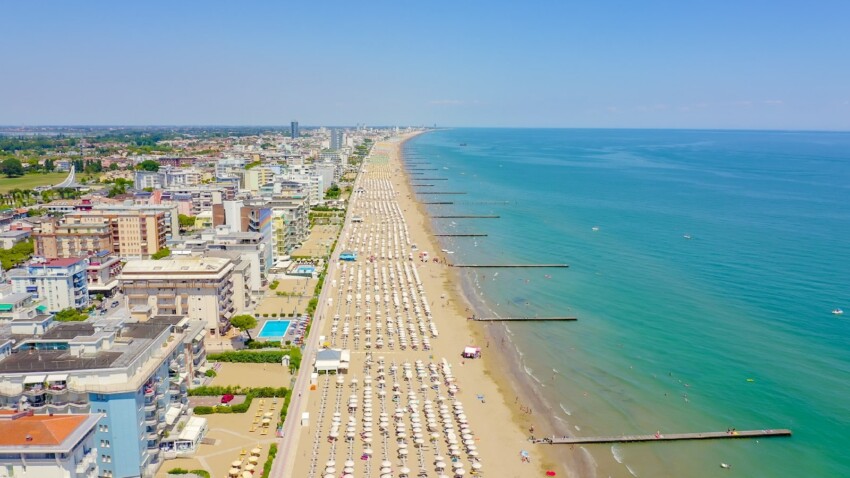
Lido di Jesolo is probably the most famous beach in Veneto and is certainly the most popular beach for young people in Veneto. Life in Jesolo revolves around the very long beach (a good 15 km!) and Via Bafile, a pedestrian street crowded at all hours of the day and night.
Although Jesolo’s fame is linked to its nightlife, this resort is also perfect for family holidays, for couples and the elderly thanks to the extraordinary offer of accommodation (you can count on an impressive number of hotels, flats, studios and holiday villages) and services for all ages.
In recent years Jesolo has expanded its tourist offer by focusing on a new image linked to environmental sustainability, cultural events and design.

The municipality of Cavallino-Treporti occupies the final tip of the peninsula that seems to close the northern part of the Venetian lagoon in an embrace. In this area, the long beach finds its place next to sandbanks, vegetable gardens and pine forests.
It is an ideal area for those who love seaside holidays in freedom: there are few bathing establishments, free beach areas prevail; campsites outnumber hotels. All the necessary services are present but do not expect worldliness or wild nightlife.
Punta Sabbioni, the southern end of the peninsula, is also part of Cavallino-Treporti. It lies directly opposite the Venetian island of Sant’Erasmo and north of Lido: from here you can easily reach St Mark’s Square by vaporetto.
Eraclea is the recommended beach for those wanting a low-cost beach holiday in Veneto. The hotels, flats and villas in Eraclea are on average cheaper than those in Jesolo, Caorle and Bibione, but even here the quality of services is very good and the sea is surprisingly clean.
In addition, Heraclea boasts a large pine forest that has earned it the nickname ‘Green Pearl of the Adriatic’. The only downside of Heraclea is the lack of entertainment and nightclubs… which for some is an advantage.

Caorle is the ideal destination for those who want to have a holiday in the sun but do not like typical seaside resorts built for tourism. This charming town is certainly the most romantic of the seaside resorts in Veneto.
The pretty historic centre is characterised by colourful houses with a Venetian imprint, delightful alleys where handicraft and souvenir shops are hidden, and a promenade that has become an open-air museum.
There are two beaches in Caorle, one east and one west of the centre; dividing them is the romantic Church of the Madonna dell’Angelo. Both are equipped beaches that alternate between bathing establishments and free areas.
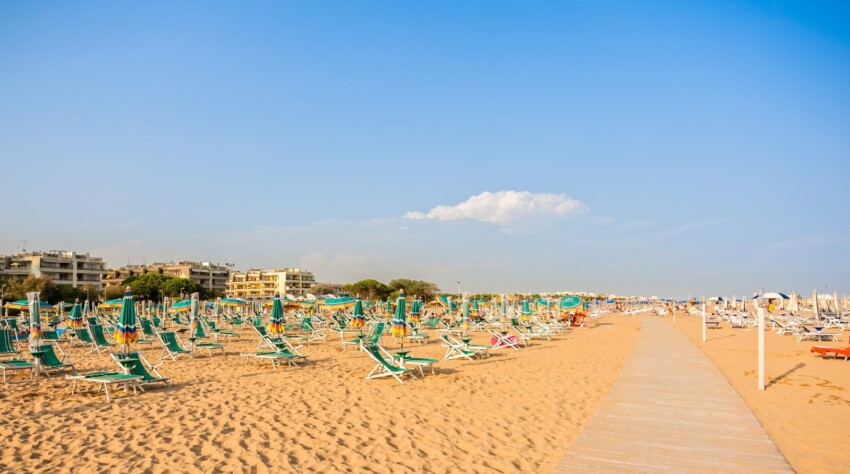
The last Veneto beach one encounters before entering Friuli Venezia-Giulia is Bibione. Here, too, tourism has been the main resource for several decades, but well before other seaside resorts Bibione focused on eco-sustainability and cycling tourism.
Clean, perfectly organised, equipped with state-of-the-art facilities and a stone’s throw from green areas of outstanding beauty, Bibione’s beach is perfect for combining comfort and nature.
Venice is immediately associated with canals, but tourists forget that the sea is just a little further away from the historic centre and it is therefore possible to combine art and relaxation on the beach in a single holiday.
It only takes 15 minutes by vaporetto from San Marco to reach the nearest beach, the VIP beach on the Lido, and from there by bus to Pellestrina. Further afield, but still ideally connected to Venice, is Sottomarina, the seaside hamlet of the characteristic city of Chioggia, known as Little Venice.
Venice’s beaches are very diverse in terms of services offered, but they mainly cater to a local tourism.
The Venetians’ beach par excellence is the Lido di Venezia, the island in front of the islands in the historic centre that separates the lagoon from the sea. It is a strip of land about ten kilometres long; the beach stretches on the western side for almost the entire length of the island.
The most famous and well-kept stretch of this long golden sandy beach is the one at the Excelsior Hotel, the luxurious hotel that has become a key venue for the Venice Film Festival. Exclusive and expensive, the Lido di Venezia beach is characterised by the capannine, the large cabins with a veranda in an elegantly retro style. Moving away from the VIP area, one can find cheaper bathing establishments and free beaches.
The connections between Lido and the centre of Venice are very good, so it is possible to base yourself here and combine a beach holiday with a visit to the beautiful Venetian capital.
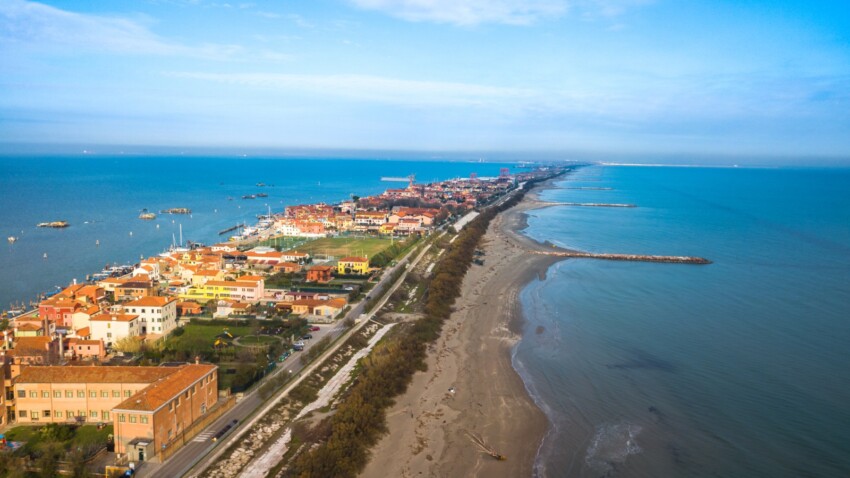
Pellestrina is the other Venetian island facing the lagoon on one side and the Adriatic on the other. It is located south of Lido, from which it can be reached by bus thanks to the ferry-boat service or by waterbus from the mainland city of Chioggia.
Although very close to Lido, Pellestrina is a completely different world where the spotlights and stars do not arrive. On the lagoon side lies the village, a picturesque succession of colourful houses; on the sea side stretches a wild beach, devoid of amenities, frequented almost exclusively by locals. Continuing on foot from the southern end of the beach, one reaches the natural oasis of Ca’ Roman.
Pellestrina is the beach in Venice recommended for nature lovers.
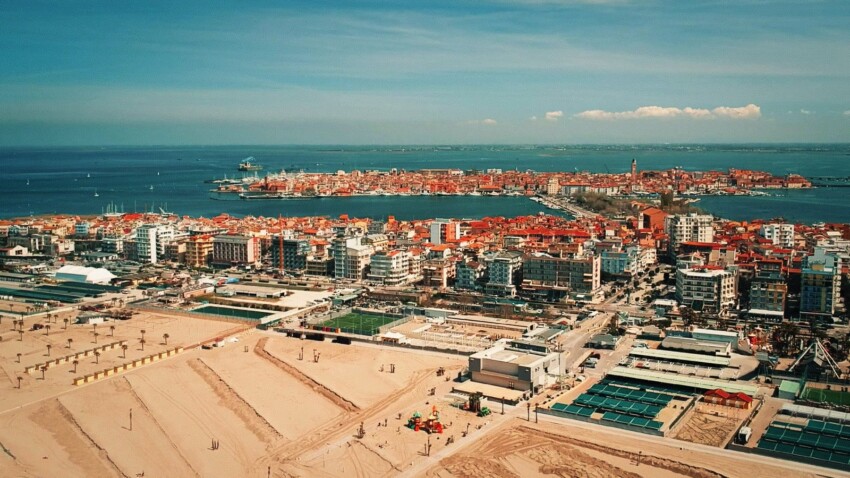
From an administrative point of view, the beach resort of Sottomarina is part of the province of Venice (and precisely of the municipality of Chioggia), but it is the people of Padua who take it by storm on hot summer days. On peak weekends, the throngs of people pouring in from Padua to ‘Marina’ in search of sun and coolness create a veritable exodus that causes kilometre-long queues along the state road.
So much affection for the Sottomarina beach is quickly explained: it is a long stretch of fine sand with a high concentration of iodine that has exceptional therapeutic qualities. It is said that the glare from this special sand gives an enviable amber colour to the skin: the only way to find out if this is true is to lie on a sunbed and wait for the sun to take effect!
Another reason why Paduans love Sottomarina is its seafront promenade full of beach bars, places to spend the evening, children’s play areas and other entertainment for all ages.
With the exception of Boschettona Beach, a free and little-known beach in the province of Padua, all the beaches in southern Veneto fall within the province of Rovigo.
These are wonderful beaches for those who love wild nature: the landscape context in which they are set is the Po Delta territory, a natural paradise characterised by an extraordinary wealth of animal and plant species.
The beaches of the Po Delta are the ideal destination for those who prefer birdsong and the lapping of the waters to the noise of discos and fashionable bars: an enchanting place where they can forget the stress of everyday life and reconnect with nature.
The watchword here is simplicity.
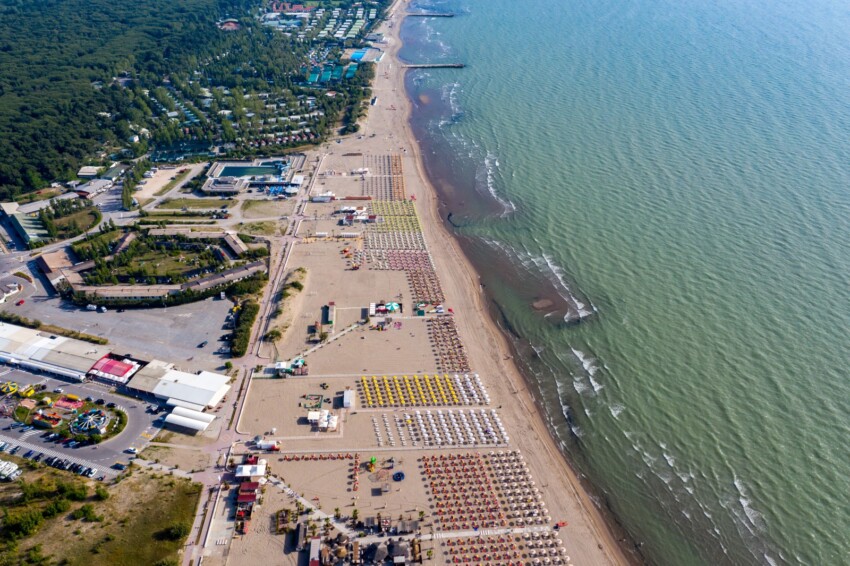
The most famous family beach in the province of Rovigo is Rosolina Mare, a quiet seaside resort lying along a peninsula washed by the Adriatic Sea, the Adige River and the fishing valleys of the Po Delta.
Rosolina’s strengths are the large pine forest behind the beach and the large number of tourist services. The choice of flats, holiday homes, bungalows and residences is very wide, and so are the attractions for children, and the prices are much more affordable than those in Albarella.
Perfect for those who want a holiday of comfort and tranquillity, it is strongly discouraged for young people looking for nightlife.
The best beach for immersing oneself in the evocative landscape of the Po Delta is the Barricata Beach in Porto Tolle, lying along the southern tip of the Delta close to the enchanting Sacca di Scardovari.
Forget glamour and nightlife, a beach holiday at Barricata is 100% beautiful scenery and relaxation. The beach includes equipped areas, with bathing establishments and beach bars, free areas and a stretch of private beach reserved for guests of the holiday village of the same name (the latter is ideal for a stress-free family holiday).
The beach is reached by a road that runs parallel to the sea, crossing a characteristic small wooden bridge.
In the following map you can see the location of the main places of interest mentioned in this article.